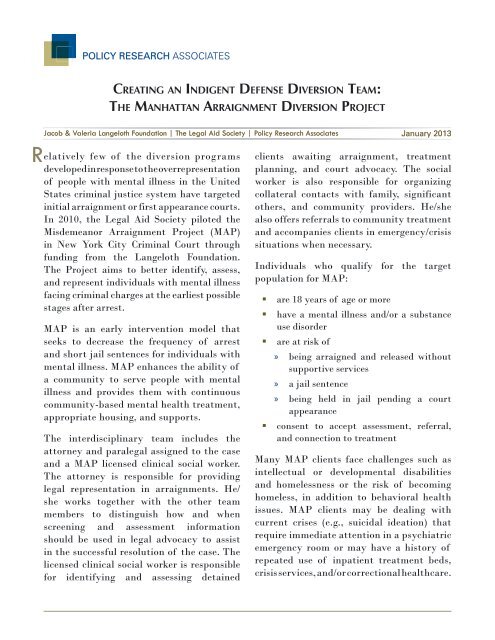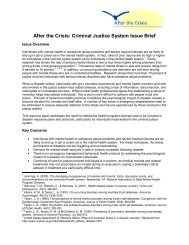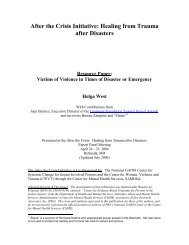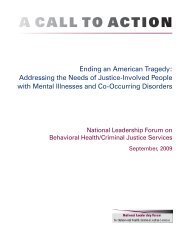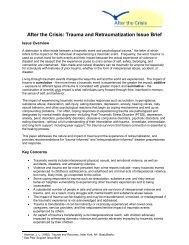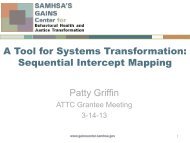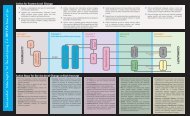The Manhattan Arraignment Diversion Project (PDF 290kb)
The Manhattan Arraignment Diversion Project (PDF 290kb)
The Manhattan Arraignment Diversion Project (PDF 290kb)
Create successful ePaper yourself
Turn your PDF publications into a flip-book with our unique Google optimized e-Paper software.
Current engagement in treatment does notpreclude a potential client from use of MAPservices.ParticipantsMAP served 250 clients between July 2010and April 2012. <strong>The</strong>se clients varied in age:20 years old and below (10%), 21-29 yearsold (20%), 30-39 years old (24%), 40-49years old (25%), 50-59 years old (16%), and60 years old and above (5%). A majority ofthe clients were male (72%). About half ofthe clients were African American (49%),followed by Hispanic (28%), Caucasian(15%), and other varied ethnicities.Mood disorders (38%) and schizophreniaand other psychotic disorders (34%) werethe most frequently seen diagnoses in clients.Overall, 57% of clients had co-occurringmental illness and substance abuse issues;22% dealt only with mental illness; 7%dealt only with substance abuse issues; and14% were missing diagnoses.<strong>The</strong> crime that preceded enrollment inMAP was most frequently larceny (29.6%),followed by controlled substance offenses(12.4%), assault and related offenses (11.6%),other offenses relating to theft (10%), andburglary and related offences (9.2%).OutcomesBetween July 2010 and April 2012, MAPcompleted 223 pre-arraignment assessmentsand 27 post-arraignment assessments. Of the223 individuals assessed pre-arraignment,149 were determined to be jail-divertibleat arraignment. Table 1 shows the finaldeterminations of all 149 cases.Table 1. 149 MAP Jail-Divertible Case Assessmentsin <strong>Arraignment</strong>sStatus N %Diverted 88 59.1Judge Denied – DOC 32 21.5Client Refused 17 11.4MAP Unable to Place 4 2.7LAS Relieved 2 1.3Parole Hold 2 1.3Transfer (MMTC) 2 1Open Warrants – DOC 1 0.7Attorney Denied – DOC 1 0.7Total 149 100Table 2. Legal Outcomes of MAP-DivertedPre-<strong>Arraignment</strong> DefendantsStatus N %ROR: Released on own Recognizance 44 50.0PGSI: Conditional Discharge 24 27.3PGSI – CASES 7 8.0PGSI: Time Served 6 6.8PGSI: Adj. Contemplation of Dismissal 5 5.79.43 – Dismissed 2 2.3Total 88 100Eighty-eight individuals (59%) were divertedat arraignment. Table 2 shows the breakdownof legal outcomes for these 88 persons.Of the 27 people assessed post-arraignment,16 (59%) were diverted, for a total of 104persons diverted. Of the 104 clients divertedbetween July 2010 and April 2012, 52% hadno arrests within one year, 16% had onearrest, 13% had two arrests, 12% had threearrests, and 7% had four or more arrests.2
<strong>The</strong> above data was compared to the numberof arrests for 61 non-MAP-diverted clients.Twenty-three clients either refused MAPservices, were unable to be placed, or theirLegal Aid Society attorney was relieved,and 38 clients were either denied diversionby the judge, were on parole hold, weretransferred, had an open warrant, or wereremanded into custody for adjudicating orsentencing. Of these non-MAP divertedclients, 25% had no arrests within one year,32% had one arrest, 11% had two arrests,10% had three arrests, and 21% had four ormore arrests. Figure 1 shows the differencein percentage of individuals arrested at 1year between MAP-diverted clients andnon-MAP-diverted clients.Figure 1. Proportion Arrested 1 Year Post-MAP80%70%60%50%40%30%20%10%0%MAP DivertedNon-MAP DivertedFour Keys to Program SuccessEducation and Engagement of the JudiciaryJudicial buy-in and appreciation of the goalsof MAP are essential to its success. Focusgroups prior to the initiation of MAP andsubsequent follow-up with judges as to theirperception of the success and usefulnessof MAP are key to evaluating potentialand ongoing success of the program.Judicial feedback may indicate potentialmodifications to procedures in the courtroom.In addition, judicial endorsement of MAPis an incentive for prosecutorial cooperationand overall success.Attorney Engagement and EndorsementAttorneys have not generally referred mattersto social workers during arraignments buthave waited until subsequent appearancesto have social workers assist. Continuouseducation of attorneys, both new andexperienced, through presentations by thesocial worker will help foster understandingof the overall arraignment part defensestrategies that can utilize social workers.Assertive Assessment and Engagement ofClients Throughout Each <strong>Arraignment</strong> Shift<strong>The</strong> social worker in this role must have a skillset suited to working with many differentpersonalities (clients, attorneys, judges) in afast-paced environment, which can often behighly charged for the client. Social workersmust screen files prior to the attorneys andtake the initiative to suggest to the attorneysthat a client could be diverted to treatmentor back to treatment. <strong>The</strong> social worker inthe MAP project has to be on the lookout forappropriate clients in all ways – reviewingfiles, discussing with the attorneys, andassessing clients visually and through initialinteraction. Some clients don’t want tospeak to anyone other than their attorney orspeak to anyone without their attorney. <strong>The</strong>skill of the social worker in making clientsfeel at ease in a difficult and potentiallytraumatizing situation is essential.3


